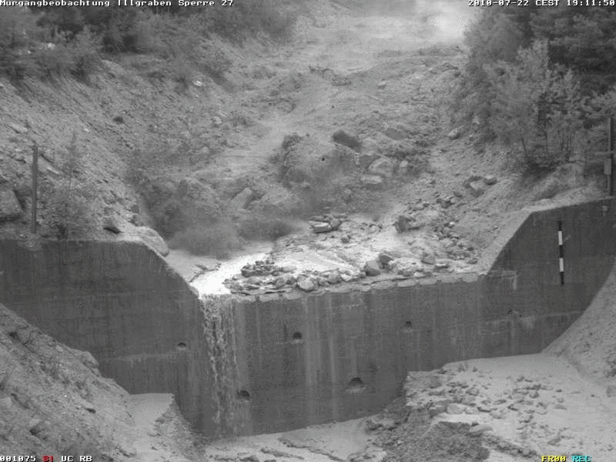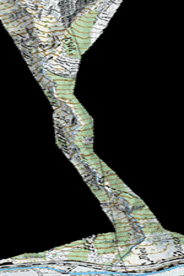We research debris flows in various ways: we observe their behaviour via automatic monitoring stations, trigger experimental debris flows in the laboratory, and simulate their courses and spread using a computer.
Contents ¶
Understanding processes through field observation ¶
We have set up multiple automatic debris flow monitoring stations in the Swiss Alps which provide us with important data sets for describing flow processes and for developing and calibrating numerical simulation programmes. Various measuring systems are used and tested at the stations.
An automatic debris flow monitoring station is currently in operation at the Illgraben. Other stations were installed in previous years and have also provided key data sets: Dorfbach, Schipfenbach, Preonzo, Riascio.
Debris flows occur in the Illgraben several times a year. This makes the site interesting for research. WSL has instrumented the channel with technical installations and observes the events in detail. It has also implemented a prototype system for a debris flow alarm system there.


Laboratory studies ¶
At WSL's large-scale laboratory we can study the trigger, transit and deposition behaviour of debris flows on a smaller scale. In a debris flow channel, we investigate the flow behaviour of different debris flow mixtures and test measuring instruments before they are used in the field. The debris flow channel (see video "Das Ding", Diagonal 2/2017) can also be used to demonstrate the characteristic features of debris flows to visiting groups.
Application and development of simulation programmes ¶
Numerical simulation programmes enable us to make reliable calculations of the flow behaviour of debris flows in the torrent on a debris-flow fan, which but also to identify critical conditions for overloading the torrent and indicate possible flow paths and at-risk areas outside of the torrent channel. We explore the limitations and possibilities of simulation programmes based on exemplary ample applications and devise recommendations and guidelines for their use in hazard analysis. This work is carried out within the RAMMS Rapid Mass Movements project.
Contribution of research to debris flow protection ¶
The findings from new field data and observations, laboratory experiments and calculations with numerical simulation programmes expand the knowledge of the complex and still insufficiently known phenomenon of debris flows. In addition, they contribute to the improvement of methods and working tools for practical use in the assessment of natural hazards and form the basis for the development and assessment of protective measures.
Short video about WSL research in the Illgraben (Gottardo Pestalozzi, WSL)
Contact ¶
Publications ¶
Projects ¶
WSL strategic initiative: Climate Change Impacts on Alpine Mass Movements (CCAMM)
Past projects:
- TRAMM2 - Triggering of rapid mass movements
- EU-Projekt "T.HA.R.MI.T": Torrent hazard control in the European alps, practical tools and methodologies for hazard assessment and risk mitigation
- Swiss Virtual Campus Projekt "Dealing with Natural Hazards and Risks". 3rd International Conference on Debris Flow Hazards Mitigtation Mechanics, Prediction, and Assessment 2003 in Davos, Switzerland - Proceedings
Services and products ¶
Experimental sites ¶
- long-term debris flow monitoring at Illgraben (VS)
- large-scale laboratory at the WSL


